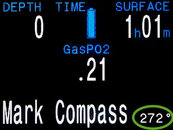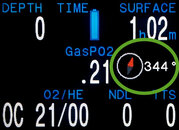Photo is not opening?
You are using an out of date browser. It may not display this or other websites correctly.
You should upgrade or use an alternative browser.
You should upgrade or use an alternative browser.
Marking a Compass Heading - Suggestion
- Thread starter BFRedrocks
- Start date
Please register or login
Welcome to ScubaBoard, the world's largest scuba diving community. Registration is not required to read the forums, but we encourage you to join. Joining has its benefits and enables you to participate in the discussions.
Benefits of registering include
- Ability to post and comment on topics and discussions.
- A Free photo gallery to share your dive photos with the world.
- You can make this box go away
tcoen
Shearwater Research
Yes, sorry about that, the photo will not attach properly to that post.
I will try again in a new post.

Also, we've added an optional compass that can be put on the main screen in the configurable locations. It is more of a traditional compass where the red needle always points to North. The azimuth value is also displayed.

Tyler
I will try again in a new post.

Also, we've added an optional compass that can be put on the main screen in the configurable locations. It is more of a traditional compass where the red needle always points to North. The azimuth value is also displayed.

Tyler
Tyler, thanks. Your company is pretty amazing.
Question re how it works. The compass is in the bottom panel. You then left push through the menu to "mark compass" and the bearing you were traveling will be displayed as shown in the photo, then right button push to set and automatically return to the compass display?
Also, I noticed at the store that it took several left presses to reach "mark compass" A suggestion: when the compass is up, use the adaptive menu to make the first left button push go directly to the "mark compass" menu item. This lets you set bearing and return to compass display with only two total pushes, very fast and easy, and your operational integrity is preserved!
Also, for the future, keep in mind the larger cardinal directions and the 90 and 120 degree marks.
THANKS!
Question re how it works. The compass is in the bottom panel. You then left push through the menu to "mark compass" and the bearing you were traveling will be displayed as shown in the photo, then right button push to set and automatically return to the compass display?
Also, I noticed at the store that it took several left presses to reach "mark compass" A suggestion: when the compass is up, use the adaptive menu to make the first left button push go directly to the "mark compass" menu item. This lets you set bearing and return to compass display with only two total pushes, very fast and easy, and your operational integrity is preserved!
Also, for the future, keep in mind the larger cardinal directions and the 90 and 120 degree marks.
THANKS!
tcoen
Shearwater Research
Tyler, thanks. Your company is pretty amazing.
Question re how it works. The compass is in the bottom panel. You then left push through the menu to "mark compass" and the bearing you were traveling will be displayed as shown in the photo, then right button push to set and automatically return to the compass display?
Also, I noticed at the store that it took several left presses to reach "mark compass" A suggestion: when the compass is up, use the adaptive menu to make the first left button push go directly to the "mark compass" menu item. This lets you set bearing and return to compass display with only two total pushes, very fast and easy, and your operational integrity is preserved!
Also, for the future, keep in mind the larger cardinal directions and the 90 and 120 degree marks.
THANKS!
Hi guyharrisonphoto,
Actually, i think your idea is a pretty good one. Normally, when showing an info screen (like the compass), the left button is a quick exit back to the main screen. However, in this case, we could make the first left press bring up the "Mark Heading" option, and the next left press return to to main. I don't think this would break the user interface rules too much, and would be much more convenient.
We'll trial it out and see how it feels. No promises though.
The ideas for the larger cardinal directions, squares, and triangles have been added to our improvements list and should make the next firmware release (although not the one being released now, v29).
I have a thought on the Mark Compass issue if you decide that guyharrison's idea breaks the intuitive UI too much. Keep the Mark Compass menu option where it is (two left button pushes), but change what the right button does when you select it. A right button push would then take you to the standard full bottom row compass display, except that to the right of the azimuth number put the word "SET" in red letters. One further right button push will then set whatever the current heading is, while a left button push will bring you back to the main menu. I would suggest that the "time out" be lengthened a little bit so that the diver can take their time setting their heading without the computer popping back to the normal display.
It's not bad, but still four pushes instead of two. I like to minimize the time it takes and the number of pushes so that your wrist doesn't shift during all the pushes (the compass is very sensitive--a good thing) and then you have to re-set again. When the compass is up (for me and I think most) it means we want it specifically to navigate, not just as a display item, and the main use is almost always setting and following a bearing. That is why I suggested the adaptive menu change and two push approach only for when the compass has already been selected. Just to compare, when the compass us up on my Galileo, it is only one push to set a bearing. That is a really nice, noticeable thing. When navigating the fewer pushes the better. With Shearwater's system, it could take only two which is almost as good. Four would be a noticeable difference especially with gloves.
I think this forum, and this company, is incredible in the intelligent thought that goes into things.
I think this forum, and this company, is incredible in the intelligent thought that goes into things.
Dear, Shearwater staff.
I would like to suggest that you add on a column for compass heading on your dive log.
Depending on storage limitations, maybe a sample every 5-10 seconds vice the depth's 1 sample/sec rate or perhaps just an entry when the mark heading feature is accessed.
I would like to suggest that you add on a column for compass heading on your dive log.
Depending on storage limitations, maybe a sample every 5-10 seconds vice the depth's 1 sample/sec rate or perhaps just an entry when the mark heading feature is accessed.
- Messages
- 7,659
- Reaction score
- 4,720
- # of dives
- 200 - 499
Nice idea, but problematic for wrist mount.Dear, Shearwater staff.
I would like to suggest that you add on a column for compass heading on your dive log. ...
Maybe first ask them to come up with a ratcheting (or ball detent) rotating wrist mount for the unit so it can be properly aligned while keeping your arms in the "parked" position. For me, that is somewhere around 45 degrees, a huge error for a compass.
Then there is heading vs. bearing to contend with. Nice idea, though. I like it.
---------- Post added September 2nd, 2015 at 11:55 PM ----------
Thought about this for a bit.
Beginning to LOVE the idea of a directional plot, but only if presented as a kinematic particle trajectory with time recast as distance. The assumption is that you keep moving at a fixed rate. No other way to do this.
Even with this limitation, such a plot would be the perfect way to observe and grade "loose navigation" after the fact. We already have the little compass, thus my intense interest.
In addition, if you were tasked with a navigational training task, you would be able to directly observe the geometric shape you were asked to swim. A rotatable mount would make this child's play.
Similar threads
- Replies
- 12
- Views
- 876
- Replies
- 59
- Views
- 5,624
- Replies
- 5
- Views
- 1,416
- Replies
- 3
- Views
- 837



